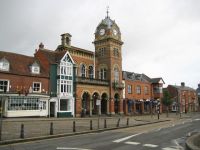Hungerford is a historic market town and civil parish in Berkshire, England, 8 miles (13 km) west of Newbury, 9 miles (14 km) east of Marlborough, 27 miles (43 km) northeast of Salisbury and 60 miles (97 km) west of London. The Kennet and Avon Canal passes through the town from the west alongside the River Dun, a major tributary of the River Kennet. The confluence with the Kennet is to the north of the centre whence canal and river both continue east. Amenities include schools, shops, cafes, restaurants, and facilities for the main national sports. The railway station is a minor stop on the London to Exeter (via Taunton) Line.
History
Hungerford is derived from a Saxon name meaning "ford leading to poor land". The town's symbol is the estoile (a six-pointed star with wavy arms) and crescent moon.
The place does not occur in the Domesday Book of 1086 but by 1241, it called itself a borough. In the late 14th century, John of Gaunt was medieval lord of the manor and he granted the people the lucrative fishing rights on the River Kennet.
The noble family of Walter Hungerford, 1st Baron Hungerford originated from the town (c. 1450–1450), although after three generations the title passed to Mary, Baroness Hungerford who married Sir Edward (afterwards Lord) Hasting and the family seat moved to Heytesbury, Wiltshire.
During the English Civil War, the Earl of Essex and his army spent the night here in June 1644. In October of the same year, the Earl of Manchester’s cavalry were also quartered in the town. Then, in the November, the King’s forces arrived in Hungerford on their way to Abingdon.
During the Glorious Revolution of 1688, William of Orange was offered the Crown of England while staying at the Bear Inn in Hungerford.
The Hungerford land south of the Kennet was for the centuries, until an 18th-century widespread growth in cultivation the area, in Savernake Forest.
St. Lawrence's parish church stands next to the Kennet and Avon Canal. It was rebuilt in 1814–181
